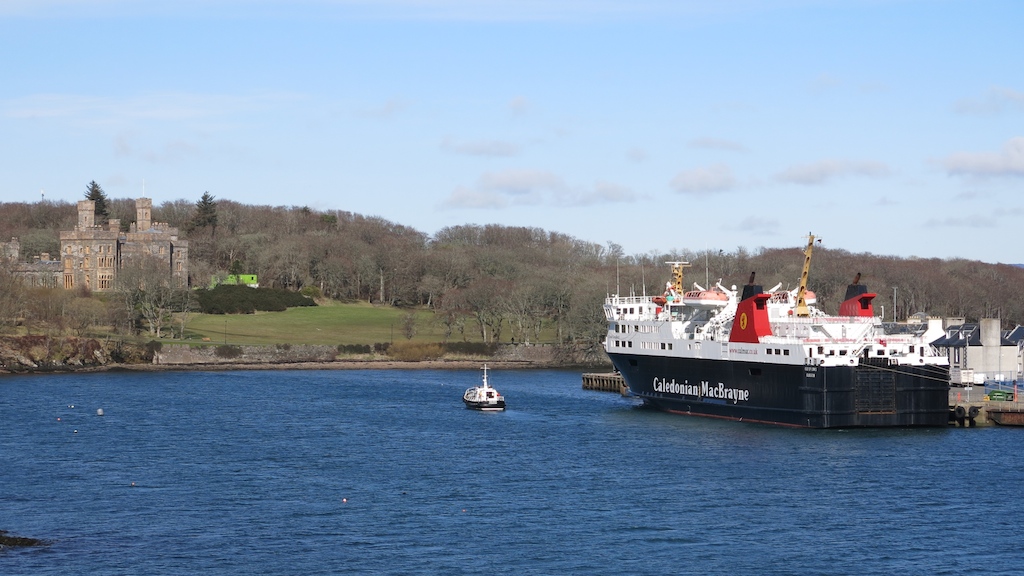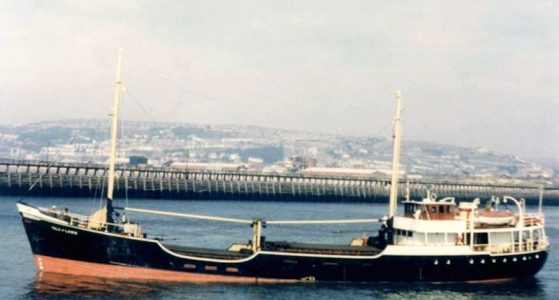
The CalMac ferry Isle of Lewis lies at Stornoway on 25 March 2015, after being ousted from the Lewis service by Loch Seaforth. Copyright CRSC
Colin Tucker explores the history of ships bearing the name of the island where he lives — Lewis.
Over the years there have been a number of ships in the Caledonian MacBrayne fleet with the same name. Clansman, Columba and Claymore are but three which spring to mind.
But there has only been one ship which bears the name Isle of Lewis. This, of course, is the ferry launched from Ferguson’s yard on the Clyde in 1995, and which operated on the Ullapool-Stornoway service until replaced by Loch Seaforth in 2015, since when Isle of Lewis has served the isle of Barra from Oban.

Since she started serving the isle of Barra, Isle of Lewis is now rarely seen at the island after which she is named. Copyright CRSC
However, while she may be the only CalMac vessel of that name, she is not unique in carrying that nomenclature. All similarly named predecessors have a connection with the island of their name, if in one case a somewhat tenuous one.
In 1903, a cargo ship was launched with the name Isle of Lewis at the Wallsend shipyard of the Tyne Iron Shipbuilding Company. Of 3,067 gross tons, she was 323 feet in length and had a beam of 47 feet. She was a typical cargo vessel of the time, with engines amidships. Her owners were Dixon, Robson & Co of Newcastle, trading under the name of the Isles Steam Shipping Company. In 1917 she was renamed Jura, and two years later she was sold to Japanese owners. Her career came to an end in October 1923 when she was wrecked on the Japanese coast at Tanechi, in Iwate prefecture.
This Isle of Lewis certainly never visited Stornoway, and it is doubtful if she even sailed on the Minch anywhere near the island of her name. What, then, was the connection with the island? The answer appeared in the columns of the Highlander newspaper in 1904. The report read as follows:
Some ten days ago a new steamer, of over 3000 tons, named the “The Isle of Lewis,” belonging to Messrs Dixon, Robson & Co, Newcastle-on-Tyne, went ashore near Plymouth on her maiden voyage.

The second bearer of the name Isle of Lewis was a small cargo ship, often seen in Hebridean waters in the 1960s
Owing to the vessel being named after our island, a number of townspeople were interested in her misfortune, and a local gentleman sent the owners a letter expressing sympathy with them in the accident, and enclosing two books of views of Lewis.
In reply he has received the following:- “We duly received your favour of the 28th ult., and beg to tender you our sincere thanks for your kind expression of sympathy in the stranding of our s.s. “Isle of Lewis.” The steamer will be floated this week, and we hope with you that she will yet prove a serviceable vessel and a fitting representative of your beautiful island. We feel very much the interest that you and your community take in the matter, and thanking you for your books of views, which are very acceptable. – We are, yours &c., Dixon, Robson & cO.”
We are pleased to observe from Wednesday’s newspapers that the “Isle of Lewis” has been successfully floated, the rocks having first been blasted from under her. May her first accident be her last!
The second Isle of Lewis was also a cargo ship, but much smaller in size. She did, however, call at Stornoway on many occasions, and was a familiar sight in Hebridean waters and further afield during the 1960s. She was brought to the west coast in November 1960 when the ship was purchased as an addition to the fleet of small cargo vessels operated by Roderick Cunningham of Scalpay.
With a tonnage of just over 400, she was a Dutch-built ship, originally carrying the name Finlandia and operating in the Baltic Sea. In 1960 her new skipper and a crew of three flew to the Netherlands to collect the ship, sailing her back originally to Ireland with a cargo. From there the ship was taken to Ayr for a Board of Trade examination. This being successful she then commenced her west coast operations.
During the seamen’s strike in 1966 Isle of Lewis was busily employed in assisting the beleaguered islanders, in particular those involved in the then blossoming Harris Tweed industry.
After a two-hour meeting between the local strike committee, the Transport and General Workers’ Union and Harris Tweed employers, it was agreed that the Harris Tweed industry should be allowed to charter a small coaster to bring in essential supplies for the industry, and to ship out the finished tweeds to mainland customers. On the Monday of the strike Isle of Lewis duly arrived at No 2 pier at Stornoway and was loaded with bales of finished tweed which she carried on the first of what was to be a number of trips.
It was expected that she would return to Stornoway on the following Wednesday and, as the Stornoway Gazette reported, “will thereafter be making regular weekly trips.” The paper clearly expected the strike to last for quite some time, but it ended after seven weeks.
Eventually, as more and more cargoes started to be carried by road, Isle of Lewis became too large and uneconomic for the Hebridean trade. She was finally sold back to the Netherlands, where she sailed under the name Tilly. Perhaps it was fortunate that the Cunninghams disposed of the ship before the CalMac ferry Isle of Lewis arrived in the 1990s, or there might have been problems with the name – shades of Queen Mary, perhaps!

Johnny Macdonald at the helm of Lewis Isle, as pictured by the Stornoway Gazette on 21 October 1967. Note the piper painted on the front of the wheelhouse
With a small stretch of the imagination it is possible to include a fourth vessel, which definitely had a Lewis connection. The year is 1967 and the location is thousands of miles away from Stornoway, in Nha Trang harbour in South Vietnam.
A Stornoway man is in charge of a small ferry carrying passengers in the harbour area. His name is Johnny Macdonald, but he is known to all as “Johnny Canadian”, on account of his having settled in that country. From there he ended up in the US Army and then landed a job with a sea transport company operating in South Vietnam. He was made skipper of a broken-down landing craft, and duly set about improving the vessel.
After months of cleaning up the rusty hulk he painted her grey and red, and christened her Lewis Isle – almost another Isle of Lewis.
He also decorated the inside of the vessel with colourful pictures of lochs and heather moors and seascapes. Finally he spent weeks painting a four foot tall piper on the front of the wheelhouse.
At the time Nha Trang was a major target area for Viet Cong bomb throwers. That did not deter the Lewisman from his daily ferry runs in and out of the harbour, sometimes carrying tourists and sailors and at other times small cargoes and parcels.
On one occasion when he was taking tourists round the coast in Lewis Isle, Viet Cong terrorists mined an oil tanker. Johnny calmly took out his camera, took a photo of the sinking tanker and carried on his journey.
Thankfully there have never been any events of that kind seen from CalMac’s Isle of Lewis.
That is the story of four very different ships, with (almost) the same names, and all with connections to the Isle of Lewis. Apart from the latest vessel to be named Glen Sannox, does any other CalMac vessel have such interesting “relations”?
If you have an answer to Colin’s question and want to contribute a few sentences about it, please write to info@crsc.org.uk

Lewis Isle was originally a US landing craft, the interior of which her Lewis-born owner decorated with pictures of lochs and heather moors for the benefit of his south-east Asian passengers

The present bearer of the name Isle of Lewis is pictured in the Sound of Mull on 8 July 2017. Copyright CRSC
Click here to join CRSC and share in the benefits — special publications, exclusive shipyard visits, organised cruises and winter talks by shipping experts.













